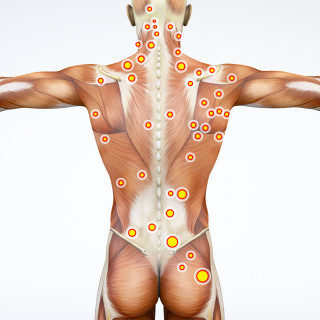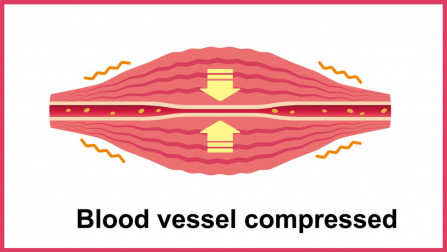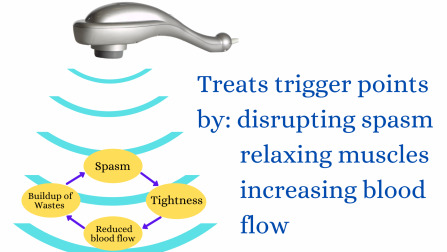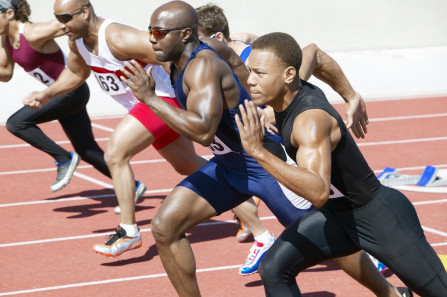How to treat trigger points at home
Trigger points can be a painful and sometimes debilitating condition that often require courses of therapy that can be painful, invasive... Read Article

In this article we will answer most of the common questions people have about “muscle knots”. For each question we will give a short concise answer, with references to complete articles should you want more information. These articles use the technical name for this condition which is myofascial trigger points, or “trigger points” for short, but they are talking about the same thing.
What are muscle knots?
What causes muscle knots?
What is the best treatment for muscle knots?
How do you release a muscle knot?
Do muscle knots go away on their own/ Why do muscle knots keep coming back?
Can you massage a muscle knot?
Does vibration help muscle knots?
Do NSAIDS help muscle knots
Does fibromyalgia cause muscle knots?
Do muscle knots affect sports and athletics performance?
What is the difference between muscle knots and acupressure points?
Do muscle knots cause headaches
Muscle knot therapy for various conditions
Muscle knots are those tender lumps in your muscles that therapists find. Of course there is no actual knot in the muscle, but they feel like knots and their pain and tightness are certainly real. They are actually part of your muscle that has tightened and won’t let go, bunching up to form the lump. This causes the muscle to tighten which presses on the blood vessels restricting blood flow, further exacerbating the problem.

There are many causes of muscle knots including injury, muscle overload and emotional stress. However, the biggest cause is where muscle tightness restricts blood blood flow creating an environment of accumulated wastes and reduced nutrients in your muscles. This is why muscle knots are so common where postural issues (eg. sitting at a computer) or repetitive activities cause muscle tightness.
Because muscle tightness is a major cause:
As mentioned in the answer to the previous question, once muscle knots form they cause muscle tightness which creates the environment for muscle knots to grow and more to develop. You will not feel the small muscle knots as they grow, but when they are large enough something may aggravate them to cause pain.
Understanding this is the key to treating muscle knots. There are many treatments that settle muscle knots down relieving pain, but if left they continue to grow and become aggravated again. Because of this the best treatment is one that:
In our article What is the best treatment for trigger points we discuss that the only practical solution that effectively settles muscle knots down and can be repeatedly applied is self applied vibration massage (not massage guns).
A muscle knot release is where the tightened part of the muscles is helped relax or “release” This allows the muscle to relax, allowing blood to flow more freely, and importantly relieve pain. The classic way to release a muscle knot is known as “ischaemic compression” or “pressure release”. To do this pressure is applied to the lump while the pain gradually fades. Therapists often do this with their thumbs or elbows, but it can be done with various tools.
While this is the way therapists have been releasing muscle knots for probably centuries we now have alternate methods of doing the same thing, often less painfully and more effectively. Some therapists use needles and laser, but arguably the easiest to apply and most effective is the use of vibration massage, (not massage guns) . For a complete description of how to release a muscle knot please see our article How to release a trigger point yourself
The simple answer to this is that muscle knots, muscle tightness, and the resultant environment caused by reduced blood flow develop slowly over time, starting long before they ever become painful. What usually happens is that treatments or courses of treatment merely settle the muscles knots down enough so they stop hurting, but the knots themselves, the muscle tightness and the reduced blood flow are still there. Of course the muscle knots keep growing and are eventually re-aggravated.
We discuss this and the solution in our article Why do trigger points keep coming back . In summary, to eliminate muscle knots completely you need to continue therapy after the pain goes, long enough to diminish and eliminate the problems completely. As we discuss, doing this using professional therapies would be very expensive, but self applied vibration massage, (not massage guns) is an effective option that can be easily and in-expensively self applied.
You certainly can massage muscle knots. We give an excellent example in this article

Vibration is actually arguably the most effective therapy for muscle knots. Vibrations can penetrate deeply into your muscles where the muscle knots lay, and have been scientifically proven to relax the muscle and increase blood flow. Most importantly when using a proper vibration massager (not massage guns) this is something you can easily do on yourself. For more information please see our article How to release a trigger point yourself
NSAIDS do not help diminish or eliminate muscle knots. They just relieve the pain. In one clinical trial self applied trigger point therapy and NSAIDS were directly compared. The NSAIDS produced a small reduction in pain only, while the self applied trigger point therapy gave a large improvement in pain and functionality. For details please see our article Is massage better than NSAIDS
It is actually the other way around. Muscle lumps are a big (untreated) cause of fibromyalgia. In summary, pain from untreated muscle lumps bombards the nervous system causing it to become sensitised. Scientists have relieved fibromyalgia by injecting the muscle knots with anaesthetic, stopping them from bombarding the nervous system. Of course anaesthetic wears off so that was only a temporary solution to show cause and effect. The long term solution would be to effectively eliminate the muscle knots. For more information please see our article How to massage for fibromyalgia

If you have muscle knots they absolutely will affect sports and athletic performance. Any muscle that is tight, has restricted blood flow and contains a bunched up lump will not perform fully, while being tight will make it more prone to being injured. Therapy to eliminate those muscle knots should help your muscles perform optimally and reduce the risk of injuries such as strains and tears. For more information please see our article The effect of trigger points on sports and athletic performance
Muscle knots and acupressure points are about 97% the same points. Centuries ago people found these points. Without science as we know it existing they made up the best story they could. In more recent times scientists have investigated these points, calling them (myofascial) trigger points. Although basically the same points the way they are used is different. If you have a specific condition and see a traditional acupuncture therapist he or she will determine which points to treat based on what people with similar symptoms had centuries ago. On the other hand a therapist using “trigger points” will identify which points to treat based upon scientifically determined factors. For more information please see our article What Is The Difference Between Trigger Points, Acupressure Points, And Other Pressure Points
Muscle knots in the head and neck muscles have been shown to be a major cause of the most common form of headache: tension headache. Trials where these have been treated gave excellent relief, This is something you can easily do yourself. For more information please see our article Self Massage And Trigger Point Therapy For Headaches And Migraines
In this section we will link to resources to help you with muscle knots for various conditions. These will use the technical term “trigger points’, but you know its the same thing.
We are continually adding more information on research and uses. Subscribe below to have us email them to you "hot off the press".

Several years ago Dr Graeme, a Chiropractor practicing in Victoria, Australia was looking for a serious hand held massager his patients could use at home to get the extra quality massage they needed. The ones he found in the shops and on-line for home use looked nice but were not serious, and... read more
Trigger points can be a painful and sometimes debilitating condition that often require courses of therapy that can be painful, invasive... Read Article
Two of the best studies of shoulder pain found that (myofascial) trigger points in 17 different muscles contribute to shoulder pain... Read Article
Although anti-inflammatory drugs are heavily advertised and routinely prescribed for pain syndromes a recent clinical trial found them to... Read Article
There are a variety of systems of “pressure points” used for health benefits and to relieve pain. They all have their devoted advocates... Read Article
Sports massages are widely used with both professional (paid) and self help options. If you are looking at sports massages the main... Read Article
If you’ve got a headache it would be nice if you do some massage or press pressure points rather than rely on drugs or other therapies. ... Read Article
According to a report in the -Journal of Shoulder and Elbow Surgery- 71% of shoulder pain sufferers are still suffering after six months.... Read Article
Do not refresh or leave this page until loading complete.